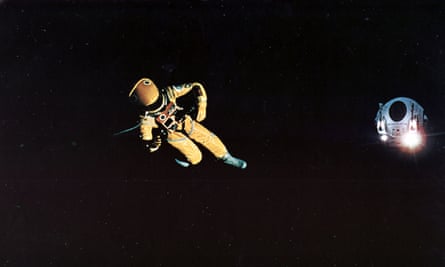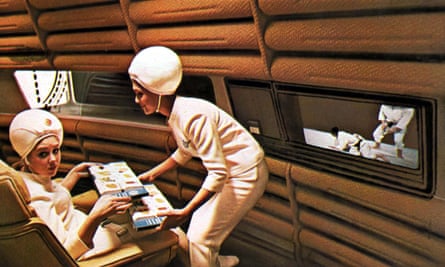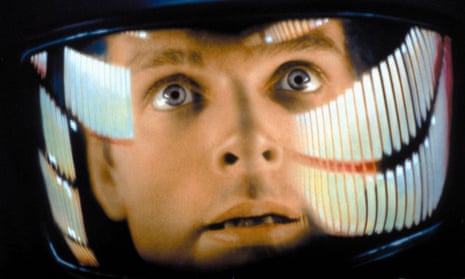This week two extraordinary films open in London. Stanley Kubrick’s 2001: A Space Odyssey (London Casino) and Don Levy’s Herostratus (New ICA Cinema, Nash House, The Mall, SW1). The first was over five years in the planning stage, two in the shooting, and cost over £3 millions. The second took two years to finance and set up; the shooting was spread out over a year, and the editing took two more years; hardly anyone was paid; the cost was £10,000. I mention these facts because they make clear neither film was churned out on the assembly line. Directors and crews worked long and hard, and both films are serious works. Playing for the highest of artistic stakes, both Kubrick and Levy have earned the right to have their films judged on the highest level. And, judged accordingly, neither is really successful.
Certainly, both are beautiful to look at. Much of Kubrick’s £3 millions went for special effects, and, for the first time ever, a science fiction film looks plausible: the spaceships with complex exteriors like early Paolozzi sculptures, the surrealistic surface of the moon, and the fantastic prehistoric landscapes. Somehow, they are lit to look like nothing we have ever seen before, only perhaps dreamed of, or briefly glimpsed in those frighteningly awesome moments just before a summer storm breaks. And in its quite different way Herostratus is stunningly photographed: W2, the twilight area between Westbourne Grove and the Harrow Road with its gasometers, its iron bridges, and rotting slums are rendered in such a way as to make them play an almost independent role in the film.
But neither film manages the much more important task: to create its own beauty – one independent of the individual shots – one which comes from the articulation of the shots, the construction of sequences, or even sometimes simply from a gracefully apt camera movement. By and large, both films remain a series of gorgeous images.

Not always: when Kubrick links yesterday, the dawn of man, the discovery of the first tool, the first weapon, with tomorrow, he has his primitive homo sapiens exultantly throw a jawbone into the air. As it slowly starts to fall, he cuts to a fantastic spaceship swirling round and round to the Blue Danube waltz. One never thought Johann Strauss would provide the music of the spheres, but somehow it seems invigoratingly right. At first. And then it goes on and on; later in the film the same effect is used again. Both Kubrick and Levy are far too self-indulgent. Effects are constantly repeated. The first time Levy tracks along a road and we miraculously see at each succeeding intersection his hero running up (or down) the cross street, the effect is breathtaking. The second time it is less so.
In Kubrick’s case I would imagine that having spent so much money on special effects – and having achieved such results – he could not resist showing them off as much as possible. (This is particularly true of the machines and the ironmongery in general.) Levy, on the other hand, claims that the “emotional imagery of a shot is given changing meaning by repeating it in different situations in the film. Each time the imagery of the shot becomes multiplied by these juxtapositions.” For me, it didn’t work that way; rather, each time we saw the same shot its effect was halved.
Kubrick claims his film is simply a speculation on the theme of extra-terrestrial life. The film begins with prehistoric men being confronted with a strange grey monolith which produces some ill-defined effect on them. We then skip to the twenty-first century. Some strange signals have been picked up on the moon; a searching party discovers they emanate from a similar (or the same?) monolith. Eighteen months later two men and a computer set out to investigate. Then follows a longish (unrelated?) sequence in which the computer rebels, and has to be “killed.” When the survivor reaches Jupiter he discovers – in an eighteenth-century drawing room – a creature which is himself but much older; then we see him, not older but infinitely younger: an embryo.

The idea would seem to be that for this other-world, past, present and future are one. This, it would have seemed to me, is where the film might almost have begun. Instead, it ends there, an interstellar shaggy dog story. Now speculation and ambiguity are fine, but it does rather look as if Kubrick and his co-writer, Arthur C. Clarke, just haven’t thought it through. They, of course, say that what they were trying to do “could not be spelled out on any literal or intellectual level.” Direct visceral impact, instead, was preferred. Fine, but the visceral approach is by definition unanalysable and unarguable. All I can say is that it didn’t work on me.
I don’t think Levy has come to grips with his subject either, but for more interesting reasons, Max, the principal character, is a bitter, failed young poet; disgusted with contemporary society, he decides to commit suicide, but in the most spectacular way possible; he hires an advertising firm to publicise the event. At first we are, I think, meant to sympathise with his total rejection of the corruption amidst which we live; later a kind of bridle is placed on the paranoia, and we are shown that Max is “composed of layer after layer of lies and self-deception,” therefore no doubt a typical product of the society he is rejecting.
Levy severely forbids us to interpret the film on a plot level, and yet there is so much rather corny plotting that it is difficult not to be affected by it. I think the whole idea of the film is vitiated – perhaps intentionally, but perhaps only subconsciously – by the fact that Max proves to be a virgin. For when he finally succeeds in making love to Clio (History? I hope not) all his rage and disgust with contemporary civilisation seem to fade away. Surely, we are not meant to think that his problems could be resolved that easily, for this would undercut the whole point of the film. Jeremiah would not have been quite so easily satisfied.
Kubrick tells us he is only speculating; Levy, that “no attempt to interpret the film in terms of conventional films or established patterns will succeed.” In both cases I think the two films fail ultimately because their directors, however brilliant, however visceral, are trying to live beyond their intellectual means. Kubrick is avowedly trying for a Moby Dick; Levy is probably even more ambitious. Neither – but is this surprising? – quite makes it.










Comments (…)
Sign in or create your Guardian account to join the discussion